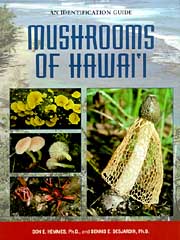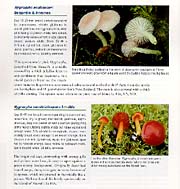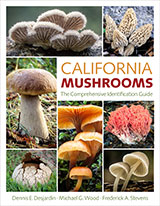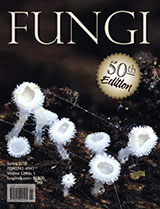Book Review
Mushrooms of Hawai'i: An Identification Guide
Once upon a time, a California mycologist visited Hawai'i on his honeymoon. After a few days of lying on the sunny beaches, he became bored and headed for the forests. Thus began Dennis Desjardin's fascination with the mushrooms of Hawai'i, and, since that first visit, he has returned many times to hunt the islands with resident mycologist Don Hemmes (who, this book informed me, traces his fungal roots to an undergraduate career at Central College of Pella, Iowa, under the tutelage of former NAMA President Don Huffman).

Together the two have produced the first field guide to the mushrooms of the 50th state. In it, you'll encounter some familiar fungal faces, but, for the most part, the mushrooms will be new ones for mainlanders.
The book opens with a short introductory section: a description of the Kingdom Fungi and what makes a fungus a fungus; summary of the organisms traditionally studied by mycologists (some, such as slime molds, are now recognized as not being true fungi); history of mycology in Hawai'i; and a rundown of when and where to find mushrooms. The latter is a bit of a tease, however, as the authors note that a permit is required for collecting in the places described.
Chapter 1 provides some brief guidelines on how to identify mushrooms like a pro, using a series of lengthily captioned illustrations. From there it's on to the mushrooms themselves.
Chapter 2 presents most of them, taking up roughly two-thirds of the book. The species are arranged by habitat (misleadingly called "vegetation zones")-lawns, compost piles and wood chips, flowerpots, pastures, guava thickets, wet windward alien forests, coastal Casuarina, coastal coconut, arid leeward coastal habitats, arid leeward montane habitats, conifer forests, Eucalyptus forests, montane Casuarina forests, mesic montane native forests, wet montane native rainforests, and Sphagnum bogs. Each section of this chapter begins with a brief description of the particular habitat. The mushrooms are presented mostly two species per page.
Each description includes a color photo (typically about 7 x 9 cm), sometimes two or three; a paragraph of macromorphologic features; and a short paragraph of commentary. The photos range from good to excellent. Some show color shifts from long or under-exposure, and others suffer from too-busy composition or too close cropping by an overly zealous editor. But there are also gems, such as Dictyophora cinnabarina and Crepidotus roseus. All are quite serviceable for identification purposes.
Each section ends with small "thumbnail" photos of additional species that can be found in that habitat but are more characteristic of another one. For each of these, a cross-reference to the habitat section that contains its full description is provided.
Chapter 2 shows clearly that there are lots of small, white-spored, saprotrophic mushrooms in Hawai'i, hence the appeal for Desjardin, who studies such genera as Marasmius, Marasmiellus, Micromphale, and Mycena. Hawai'i has few, if any, native ectomycorrhizal plants. Thus, there are not many large mushrooms from genera such as Cortinarius, Russula, Lactarius, Amanita, Inocybe, and Boletus. Those that do occur are immigrants, associated with introduced ectomycorrhizal trees such as Monterey pine and eucalyptuses.

Many of the species illustrated have been newly described by the authors, and they have done an admirable job of incorporating Hawaiian terms into the scientific names. For instance, the specific epithet of Hygrocybe noelokelani means "pink rose in the mist," while that of H. pakelo means "slippery like a fish"!
In Chapter 3, a variety of "other" Hawai'ian fungi are presented. In contrast to the generally larger, fleshy fungi of Chapter 2, these include less obvious things such as rusts, lichens, slime molds, animals that feed on fungi, and fungi that feed on animals. Many of the slime mold photos are particularly attractive.
A series of additional short chapters follows, dealing with medicinal mushrooms, poisonous mushrooms, hallucinogenic mushrooms, culturing mushrooms at home, and edible mushrooms (with a few recipes from locals). The lists of all these fungi are short, as not many occur in the Islands. A glossary, list of common and scientific names of mushrooms and trees, list of Hawai'ian terms, bibliography, author information, and index complete the book.
Overall, this is an attractive book, and it would be useful to anyone planning to visit the Hawai'ian Islands. However, because most of the mushrooms either occur very widely (such that they appear in many guides) or only in Hawai'i, the book probably will not be a priority purchase for mainland mushroomers not planning a visit. Perhaps the publisher has anticipated the effect this will have on sales, as the price has been set at a very high $39.95. But if you can afford it, this is a good place to start learning about fungi from exotic places. Who knows, lying on a tropical beach might not be to your liking.
— Review by Steve Trudell, Seattle, WA
— Originally published in The Mycophile 43:5-6, 2002


